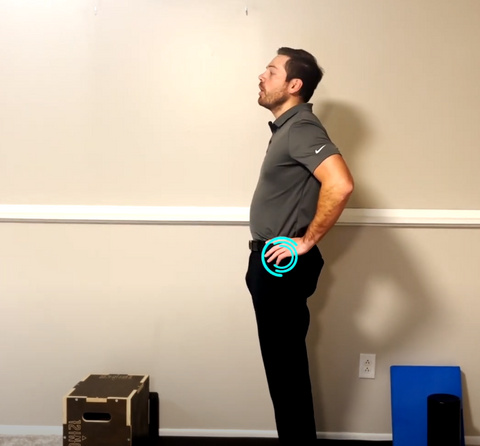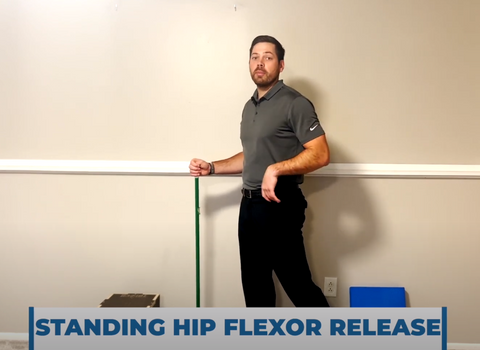What is Sciatica?
Sciatica is the general term used to describe pain along the sciatic nerve distribution. The sciatic nerve runs from the lumbar spine, down the leg, and into the bottom of the foot.
It can be irritated by a myriad of conditions including lumbar stenosis, herniated discs, and tight musculature through the lumbar spine and glutes.
Importance of Stretching for Sciatic Relief
Stretching is just one of several ways you can reduce tension on the sciatic nerve. It can target the muscles that get tight and cause compression of the nerve.
Once this pressure is relieved, many people experience relief from their symptoms. It is important to ease into stretching as you do not want to provoke your symptoms or increase stress on the nerve.
Listen to your body as you stretch and use it to determine how deep of a stretch is comfortable.
Effective Standing Stretches for Sciatic Relief
#Exercise 1: Standing Hamstring Isometric

For this exercise, you will need a something to prop your leg on (step, box, chair) and something to hold onto for support (i.e. the wall, a cane, broomstick, etc.).
- Stand with the heel of your affected foot on top of a step. Make sure you are holding onto something for support as you do not want this to be a balance exercise.
- Keep a slight bend in your knee as you bring your toes towards you. This should create a little tension in the back of your leg.
- Hinge at your hips bringing your belly button towards your leg until you feel a pull down the back of your leg. Make sure your back stays straight as you lean.
- Hold this stretch for 20-30 seconds while you press your heel into the box. Imagine using 50-70% of your max effort to push your heel down.
- Return to your starting position. When you are ready, lean deeper into the stretch and hold again.
- Repeat for 2-3 rounds with 20-30 second hold each time.
#Exercise 2: Standing Lumbar Extension
This exercise works best for sciatica caused by disc compression. It will be more tolerable and effective for people whose pain reduces when they stand and increases when they sit.

- Stand with feet and knees together and place your hands on your hips.
- Lean back as you push your hips forward as far as comfortable.
- Hold extended position for 2-3 seconds before returning to your starting position.
- Perform 2-3 rounds of 10 repetitions.
#Exercise 3: Standing Hip Flexor Release

- Place affected leg a step behind your non-affected leg so that you are in a staggered stance. You may need to hold onto something for support, so you do not lose your balance.
- Keep your back straight and weight in the toe of your back leg so you are not standing with your foot flat on the ground.
- Squeeze the glute of your extended leg until you feel a pull in the front of your hip and tightening where it hurts in the back of your hip.
- Imagine you’re trying to squeeze your butt cheeks together – this will ensure you are activating the right muscle group.
- Hold the squeeze for 20-30 seconds before you relax.
- Wait 10-15 seconds before you squeeze again.
- Repeat 2-3 times.
#Exercise 4: Seated Sciatic Nerve Glide

While not a standing exercise, this may be one of the most important stretches for your sciatic nerve. While the nerve does not stretch the same way a muscle does, this exercise will help reeducate and desensitize the nerve. It may be uncomfortable so perform to your tolerance.
- Sit with relaxed posture.
- Slowly kick out your affected leg until you feel a pull in the back of your leg. Your leg does not need to be straight, so stop whenever you feel the tug.
- Once in this position, slowly pull your toes up towards you. This will intensify the stretch.
- Point your toes again and relax your leg.
- Repeat 2-3 rounds of 10 repetitions.
Keep in mind you are not trying to push into pain with this exercise, so stop before you feel the stretch has become painful. The goal is to move in and out of the stretched position, not to hold any one position for a length of time.
Incorporating Stretches into Your Daily Routine
It is important to try to add exercises like the ones mentioned above into a regular stretching routine if you suffer from low back pain and sciatica. Once you determine which muscles are usually tight on you and the best stretches for them, keeping up with a routine can help reduce pain and prevent future flare ups.
When to Seek Professional Help
If you find home remedies like ice and stretching aren’t providing enough relief, it may be time to see a professional. Typically, the process begins with a visit to your primary care physician as they can help you determine next steps. Physical therapy and pain management are also extremely helpful for this condition.
When in doubt, call your doctor as they can provide answers to any questions you may have and guidance on what to do next.

![Best Sciatica Standing Stretches for Instant Relief - [Step-by-Step Video]](http://www.easyposturebrands.com/cdn/shop/articles/Standing_Stretches_at_Work_and_Home_youtube_thumbnail.jpg?v=1699641930&width=1100)